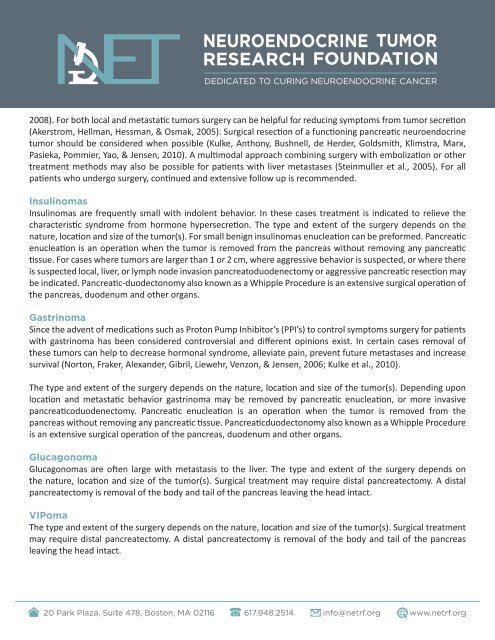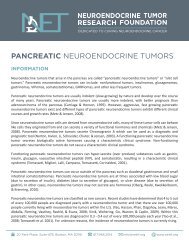PANCREATIC NEUROENDOCRINE TUMORS
You also want an ePaper? Increase the reach of your titles
YUMPU automatically turns print PDFs into web optimized ePapers that Google loves.
2008). For both local and metastatic tumors surgery can be helpful for reducing symptoms from tumor secretion<br />
(Akerstrom, Hellman, Hessman, & Osmak, 2005). Surgical resection of a functioning pancreatic neuroendocrine<br />
tumor should be considered when possible (Kulke, Anthony, Bushnell, de Herder, Goldsmith, Klimstra, Marx,<br />
Pasieka, Pommier, Yao, & Jensen, 2010). A multimodal approach combining surgery with embolization or other<br />
treatment methods may also be possible for patients with liver metastases (Steinmuller et al., 2005). For all<br />
patients who undergo surgery, continued and extensive follow up is recommended.<br />
Insulinomas<br />
Insulinomas are frequently small with indolent behavior. In these cases treatment is indicated to relieve the<br />
characteristic syndrome from hormone hypersecretion. The type and extent of the surgery depends on the<br />
nature, location and size of the tumor(s). For small benign insulinomas enucleation can be preformed. Pancreatic<br />
enucleation is an operation when the tumor is removed from the pancreas without removing any pancreatic<br />
tissue. For cases where tumors are larger than 1 or 2 cm, where aggressive behavior is suspected, or where there<br />
is suspected local, liver, or lymph node invasion pancreatoduodenectomy or aggressive pancreatic resection may<br />
be indicated. Pancreatic-duodectonomy also known as a Whipple Procedure is an extensive surgical operation of<br />
the pancreas, duodenum and other organs.<br />
Gastrinoma<br />
Since the advent of medications such as Proton Pump Inhibitor’s (PPI’s) to control symptoms surgery for patients<br />
with gastrinoma has been considered controversial and different opinions exist. In certain cases removal of<br />
these tumors can help to decrease hormonal syndrome, alleviate pain, prevent future metastases and increase<br />
survival (Norton, Fraker, Alexander, Gibril, Liewehr, Venzon, & Jensen, 2006; Kulke et al., 2010).<br />
The type and extent of the surgery depends on the nature, location and size of the tumor(s). Depending upon<br />
location and metastatic behavior gastrinoma may be removed by pancreatic enucleation, or more invasive<br />
pancreaticoduodenectomy. Pancreatic enucleation is an operation when the tumor is removed from the<br />
pancreas without removing any pancreatic tissue. Pancreaticduodectonomy also known as a Whipple Procedure<br />
is an extensive surgical operation of the pancreas, duodenum and other organs.<br />
Glucagonoma<br />
Glucagonomas are often large with metastasis to the liver. The type and extent of the surgery depends on<br />
the nature, location and size of the tumor(s). Surgical treatment may require distal pancreatectomy. A distal<br />
pancreatectomy is removal of the body and tail of the pancreas leaving the head intact.<br />
VIPoma<br />
The type and extent of the surgery depends on the nature, location and size of the tumor(s). Surgical treatment<br />
may require distal pancreatectomy. A distal pancreatectomy is removal of the body and tail of the pancreas<br />
leaving the head intact.<br />
20 Park Plaza, Suite 478, Boston, MA 02116 617.948.2514 info@netrf.org www.netrf.org
















